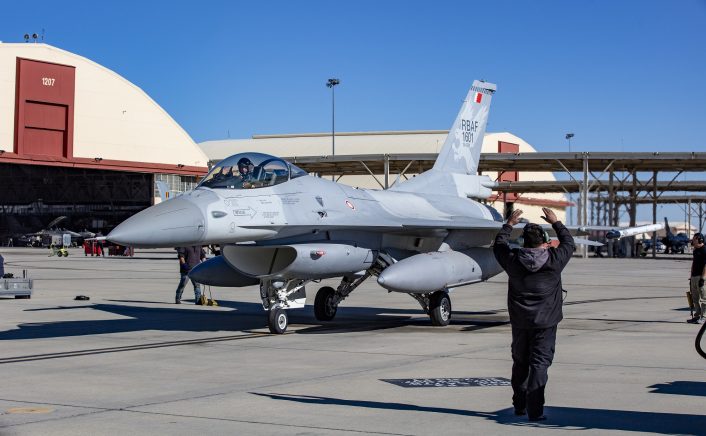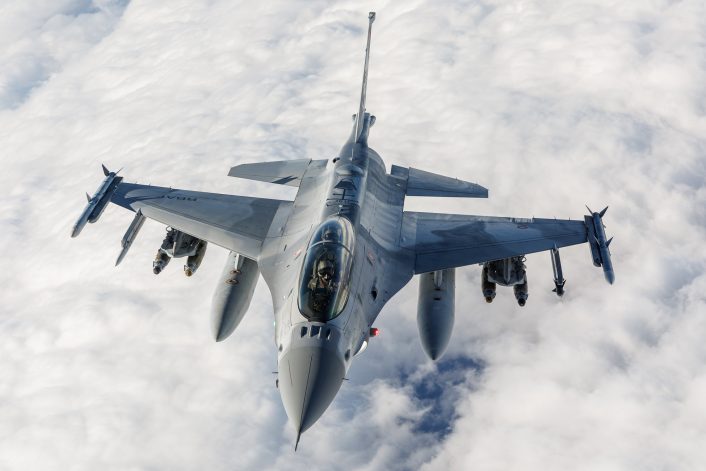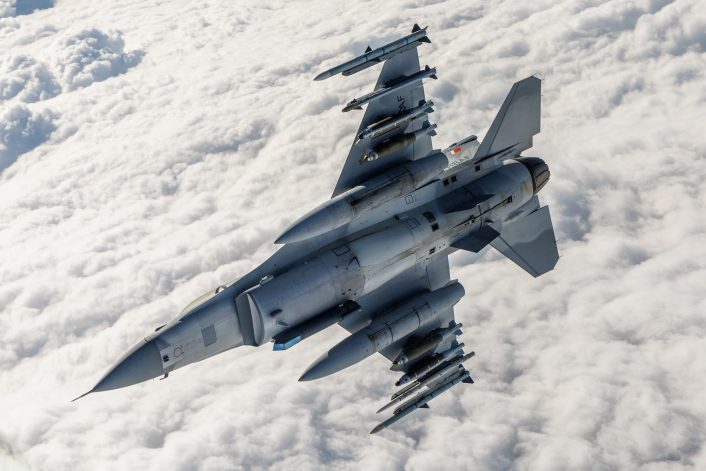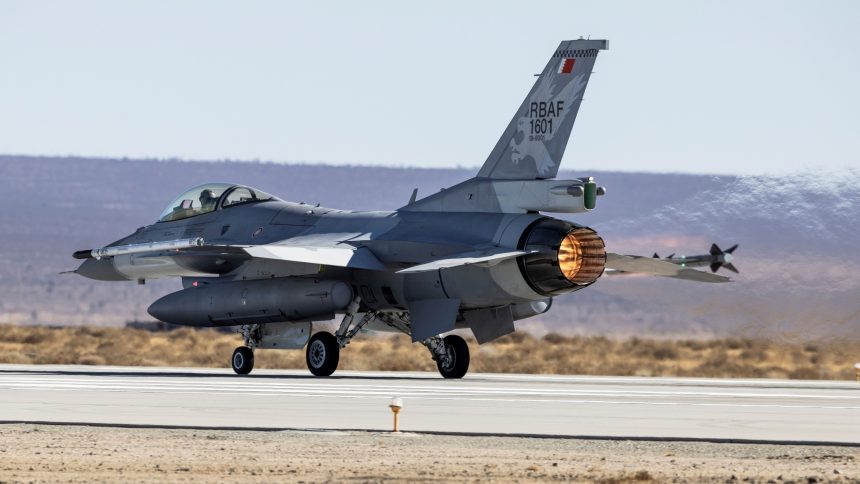The first flight of the new AN/ALQ-254(V)1 Viper All-Digital Shield Electronic Warfare suite was performed on an F-16C Block 70 of the Royal Bahraini Air Force at Edwards Air Force Base.
The U.S. Air Force has released photos and a video announcing the first flight of the new AN/ALQ-254(V)1 Viper All-Digital Shield Electronic Warfare suite on the F-16. The aircraft used for the test was an F-16C Block 70 of the Royal Bahraini Air Force, flown by a test pilot of the 416th Flight Test Squadron, Airpower Foundations Combined Test Force, at Edwards Air Force Base, California.
The Viper Shield suite was designed to maximize the survivability of the F-16 Block 70 against future threats, and will be equipped by a number of nations, including Bahrain. The choice of a Bahraini jet is not casual, as two F-16s are at Edwards AFB and are being flown by U.S. Air Force for the ongoing testing and evaluation work as part of the Foreign Military Sales process.
“The thing that we’re most excited about is the advances in the EW capabilities that Viper Shield will bring to the F-16,” said Maj. Anthony Pipe, the pilot assigned to the test flight. “One of the biggest advantages is going to be the ability of the RWR, or Radar Warning Receiver, to more accurately display, in a more accurate way and in a better human factors way, to the pilots the threats they may face.”
Viper Shield
L3Harris, the developer of Viper Shield, already anticipated the launch of a flight-test campaign when it announced in November 2024 that it had completed laboratory-based safety of flight qualification activities on the system. The company said that Viper Shield “passed a series of environmental and electrical tests across structural integrity, thermal and electrical safety, and aircraft aerodynamics,” and also “handled the [simulated] stresses and strains of normal and extreme flight maneuvers […] and proved to be safe, reliable and effective”.
L3Harris says it developed the new AN/ALQ-254(V)1 Viper Shield in partnership with Lockheed Martin and the U.S. Air Force to provide U.S. allies with “cutting-edge countermeasures against sophisticated, ever-changing threats.” The company says that the system, composed of six line-replaceable units (LRUs) and a cockpit display, is based on an all-digital architecture which uses commercial-off-the-shelf (COTS) technology for enhanced system performance, a smaller form factor, reduced weight and easier future upgrades.

Viper Shield’s digital radar warning receiver (DRWR) technology integrates seamlessly with the aircraft’s new APG-83 active electronically scanned array (AESA) radar, says the product’s page, to deliver greater situational awareness. The system also includes a digital radio frequency memory (DRFM)-based jamming system, which provides enhanced capability against advanced threats.
The manufacturer says it designed Viper Shield with fewer critical components than previous generation EW systems not only to obtain a smaller form factor and reduced weight, but also a higher mean time between failure and lower lifecycle costs. The modular design, which supports swapping LRUs in the field, together with the COTS technology and software-defined architecture, allow to simplify future upgrades as technology and threats evolve.
L3Harris is already on contract to provide Viper Shield to “six international partners” for installation on 168 new F-16s. Among the F-16 Block 70s that will receive the system, according to FMS notifications, are Bahrain, Bulgaria, Morocco, Slovakia, and Taiwan. Greece and Jordan are also acquiring Block 70s, but have not disclosed which EW suite they will use.
The delivery of Viper Shield is expected to start in late 2025, entering service during the next year.

Bahraini F-16s at Edwards
As mentioned in previous articles here at The Aviationist, the Royal Bahrani Air Force is the first operator of the F-16 Block 70. Because of this, two of its jets (a single seater and a twin seater) are at Edwards Air Force Base, California, to help with the ongoing testing and evaluation.
These F-16s are flown by test pilots of the 416th Flight Test Squadron, the core of the Airpower Foundations Combined Test Force (CTF) and part of the 412th Test Wing. In March 2024, as the first jets were being ferried to Bahrain, the U.S. Air Force released photos of the two jets at Edwards fully armed with inert munitions for testing.
“The 416th Flight Test Squadron’s rigorous evaluation of the F-16 Block 70 jets ensures that these aircraft meet the highest standards of performance and safety, which is crucial for the operational success of Bahrain’s air defense forces,” a spokesperson for the 412th Test Wing told The War Zone in a statement after the photos were released. “F-16 Foreign Military Sales test and evaluation, completed by the Airpower Foundations CTF, ensures that we as a nation meet commitments made to our allies to deliver reliable, combat-effective systems.”

The F-16s were loaded with 500 lb GBU-38 JDAM and GBU-54 Laser JDAM, AIM-120C and AIM-9X missiles, in addition to external fuel tanks and a Sniper targeting pod. Bahraini F-16s have been acquired with multiple types of weapons, including, in addition to the ones already mentioned, AGM-84 Harpoon anti-ship missiles, AGM-88 High-Speed Anti-Radiation Missiles (HARM), AGM-154 Joint Stand-off Weapon (JSOW) and GBU-39/B Small Diameter Bombs (SDB) glide bombs, and various JDAM and Paveway bombs.
The RBAF has already operated F-16s since the 1990s, although they are the older Block 40 variant. The new Vipers are a completely different beast, with multiple upgrades over the older variant such as a new cockpit, datalinks, digital EW suite and the AN/APG-83 SABR active electronically scanned array (AESA) radar.









